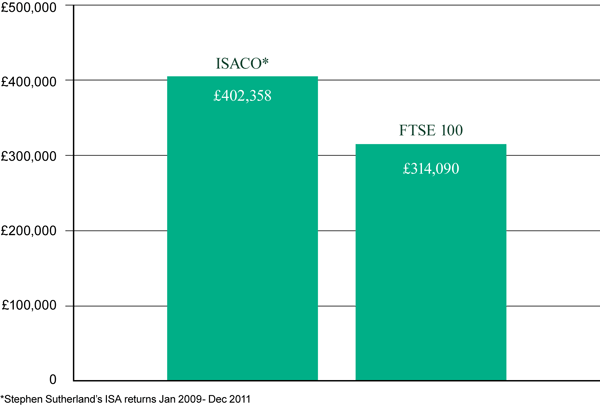 How far would your wealth have to drop during a stock market correction before you felt uncomfortable? To help you answer this difficult question, in this post we'll look at the returns that we and our clients have achieved over the last three years1, as well as two other salient points:
How far would your wealth have to drop during a stock market correction before you felt uncomfortable? To help you answer this difficult question, in this post we'll look at the returns that we and our clients have achieved over the last three years1, as well as two other salient points:
- Performance of a £250,000 portfolio (Jan 2009 – Dec 2011)
- How an investor's wealth temporarily drops during a market correction
1January 2009-December 2011
ISACO investment performance verified by Independent Executives Ltd
As you will soon discover, aiming for outperformance comes at a cost of increased short-term risk and volatility. Aiming for outperformance means taking on more risk and involves sitting through sizeable correction periods without pulling the ‘sell’ trigger. Take a look at the data and ask yourself how you would have felt if you had experienced a similar three year investment period. First we’ll look at the total return over the period.
Performance of £250,000 portfolio (Jan 2009 – Dec 2011)
The bar chart below shows how a starting portfolio fo £250,000 would have grown if invested with ISACO versus investing into a FTSE 100 tracker fund.

This growth enjoyed by our clients was achieved by attaining a three year cumulative gain of 60.5 per cent. Gaining 60.5 per cent helped our clients achieve an average annual return of 17 per cent over the three years. The FTSE 100 over this period returned 7.9 per cent per year.
Our client’s outperformance may appear to some investors as impressive, especially with beating the FTSE 100 by such a wide margin, but their double digit gains came with added risk. For example to make the annualised 17 per cent return, our clients annual returns consisted of a 56.4 per cent gain in 2009, a 27.2 per cent gain in 2010 and a 19.1 per cent loss in 2011.
Temporary falls during a stock market correction
During this three year period, there were numerous stock market correction periods of various lengths and depths. In 2009, the year our clients returned 56.4 per cent, the largest correction during the year was 8.7 per cent. This correction began on 15th October 2009 and bottomed on 30th October 2009.
In 2010, the year our clients returned 27.2 per cent, our clients experienced two significant market corrections. The first began on 12th January 2010, bottomed on 6th of February 2010 and was 14.4 per cent in depth. The second retracement started on 5th April 2010, found a floor on 6th July 2010 and was 14.9 per cent in depth. In 2011, the year our clients made a 19.1 per cent loss, their portfolio had a large correction period that began 5th January and didn’t find a bottom until 6th Oct. This retracement turned out to be 24 per cent in depth.
Taking all this data into consideration, one question you could ask is, was the aim of outperformance worth the risk? Another question to ask is, would your current emotional tolerance threshold allowed you to stomach the numerous stock market corrections over that period? For example, how would you have felt taking a temporary hit on your portfolio of 19.1 per cent in 2011? A 19.1 per cent drop on a £50,000 portfolio would have resulted in a £9,550 temporary loss, however if your portfolio was £250,000, the same drop would have resulted in a temporary loss of £47,750.
Valuable insights taken from historical data
Reviewing past stock market corrections remind us just how frequently they occur. This reflective exercise is not intended to minimize the discomfort that stock price declines generate for most investors, but rather to demonstrate the cyclical ebbs and flows in equity prices that regularly occur in a well-functioning stock market.
Take a look at this historical data on the frequency, duration and depth of stock price declines since 1928. This data is taken from the S&P 500, a US index similar in many ways to the FTSE 100. In the table below, notice the depth, historical frequency and duration of market declines.

We’ll close this blog with a final point worth remembering: When aiming for outperformance, the correction periods that you’re going to experience are likely to be more severe than the general market's correction periods. This means when the market corrects 20 per cent, an adventurous investor’s portfolio may correct as much as 30 per cent. This should be seen as normal and natural when seeking outperformance over the long-term.
As always, if you have any questions or thoughts on the points I've covered, please leave a comment below or connect with us @ISACO_ on Twitter.
You might also find these recent posts interesting:
Assessing your tolerance of investment risk
5 key factors that can affect your investment risk tolerance
Please note past performance should not be used as a guide to future performance, which is not guaranteed. Investing in Funds should be considered a long-term investment. The value of the investment can go down as well as up and there is no guarantee that you will get back the amount you originally invested.
About ISACO
ISACO was established in 2001 by brothers Stephen and Paul Sutherland and is the first financially regulated firm to offer adventurous ISA and SIPP investors a unique personal investment service that shares on a daily basis our star-performing investor’s thoughts, personal insights and investment decisions.
Clients enjoy being informed throughout the year what ‘best of breed’ funds our premier investor currently owns, when he’s buying and when he’s moving into the safe harbour of cash – helping clients enjoy more control, manage their portfolio more effectively and benefit from the potential of outstanding long-term returns.
For more information about ISACO and our Investment Guidance Service, please read our free brochure.














